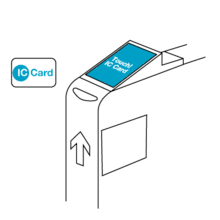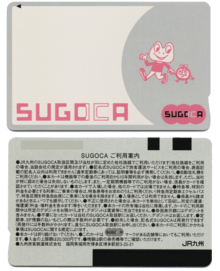SUGOCA
SUGOCA (スゴカ, Sugoka) is a Japanese rechargeable contactless smart card ticketing system for public transport in Fukuoka Prefecture and environs. The Kyūshū Railway Company (JR Kyūshū) introduced the system on 1 March 2009. The name is an acronym of "Smart Urban GOing CArd", while sugoka (凄か) in the local Kyūshū dialect means "great". Like other electronic fare collection systems in Japan, the card uses RFID technology developed by Sony Corporation, known as FeliCa. American graphic artist Rodney Greenblat designed its official mascot, a frog with a clock.




On March 13, 2010, SUGOCA has been interoperated with two similar cards in Fukuoka—namely nimoca by Nishi-Nippon Railroad (Nishitetsu) and Hayakaken from Fukuoka City Transportation Bureau—plus Suica, a card used in Greater Tokyo Area by East Japan Railway Company (JR East).[1] Additionally, since March 5, 2011, in a reciprocal agreement with Central Japan Railway Company (JR Central) and West Japan Railway Company (JR West), SUGOCA is also usable in Osaka-Kobe-Kyoto, Okayama-Hiroshima and Nagoya metropolitan areas. Similarly, the TOICA card of JR Central and the ICOCA card of JR West can also be used on JR Kyushu rail services.[2]
Usable area
SUGOCA was implemented on March 1, 2009, in 124 JR stations in Fukuoka Prefecture, mainly in the Fukuoka-Kitakyūshū area. It will eventually be usable in a total of 144 stations in future.
- Chikuhi Line: Meinohama — Nishi-Karatsu
- From March 13, 2010.
- Chikuhō Main Line: (Fukuhoku Yutaka Line, Wakamatsu Line): Wakamatsu — Orio — Keisen
- Kagoshima Main Line: Mojikō — Arao
- Karatsu Line: Karatsu — Nishi-Karatsu
- From March 13, 2010.
- Kashii Line (Umi-no-Nakamichi Line): Saitozaki — Umi
- Nagasaki Main Line: Tosu — Saga
- Nippō Main Line: Nishi-Kokura — Nakatsu
- Sasaguri Line (Fukuhoku Yutaka Line): Keisen — Yoshizuka
- Sanyō Main Line: Shimonoseki — Moji
- From March 5, 2011.
- Kagoshima Main Line: Arao — Yatsushiro and Sendai — Kagoshima
- Hohi Main Line: Kumamoto — Higo-Otsu and Nakahanda — Oita
- Ibusuki Makurazaki Line: Kagoshima Chuo — Kiire
- Kyudai Main Line: Kurume — Zendoji and Mukainoharu — Oita
- Nagasaki Main Line: Nagasaki — Isahaya
- Nippō Main Line: Nakatsu — Kozaki and Kokubu — Kagoshima, except for Ryūgamizu
- Omura Line: Isahaya — Takematsu
- From December 1, 2012.
Types of cards
There are currently three types of cards available. The SUGOCA ticket is available as either an Unregistered card, or as a Registered card, where the card can be reissued when lost. The second is the SUGOCA commuter pass (which requires registration), and the Excell pass, which can be used for non-reserved seats of limited expresses. The third form is the mono SUGOCA, which is functionally identical to the normal SUGOCA pass, but is patterned differently for the Kitakyushu Monorail. It was issued starting October 1, 2015.[3]
Extended functionality
The card is also usable as an electronic money or cashless card in a few stores in Fukuoka prefecture, or to purchase beverages at some drink machines. It will eventually be usable in all 'ampm' convenience stores in Kyūshū. From July 22, 2014, Pasmo cards can be used to pay for Wii U Nintendo eShop digital video games with the NFC function of the Wii U GamePad.[4]
See also
References
- Official news release Archived 2008-02-11 at the Wayback Machine by JR Kyūshū, February 7, 2008. (in Japanese)
- Official news release Archived 2011-03-08 at the Wayback Machine by JR West, November 25, 2009. (in Japanese)
- ICカード、QR乗車券ご利用ガイド. Kitakyushu Monorail (in Japanese). Kitakyushu Monorail Co., Ltd. 1 Oct 2015.
- https://www.youtube.com/watch?v=Z3mAYihmqrM
External links
- (in Japanese) Official website